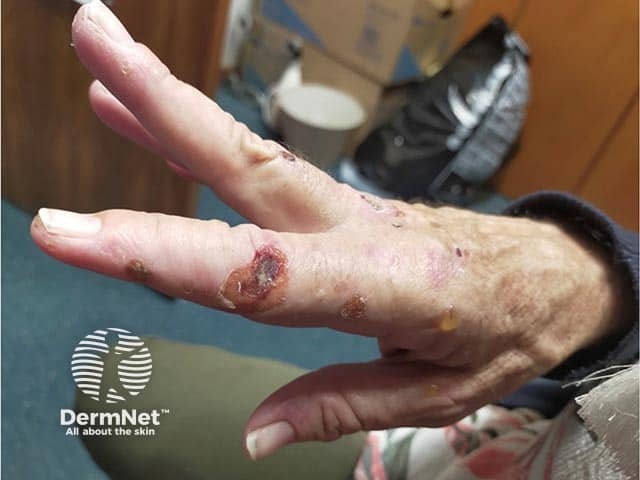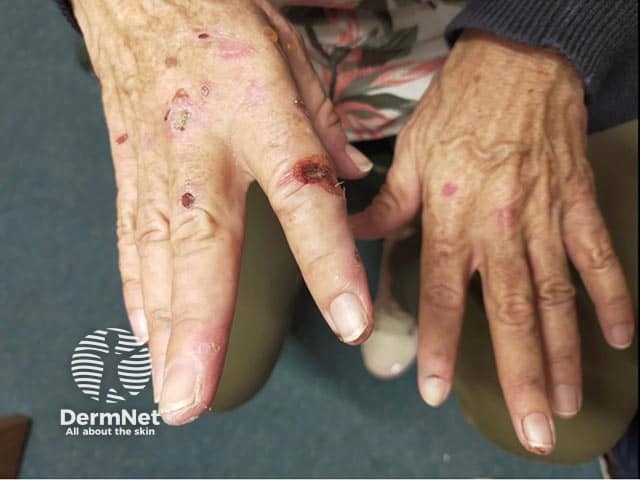Main menu
Common skin conditions

NEWS
Join DermNet PRO
Read more
Quick links
Hereditary coproporphyria — extra information
Hereditary coproporphyria
November 2022
Author: Dr Julia Zhu, Dermatology Advanced Trainee, New Zealand (2022)
Reviewing dermatologist: Dr Ian Coulson
Edited by the DermNet content department
Introduction Demographics Causes Clinical features Complications Diagnosis Differential diagnoses Treatment Outlook
What is hereditary coproporphyria?
Hereditary coproporphyria (HCP) is a rare subtype of porphyria characterised by a defect in the coproporphyrinogen oxidase (CPOX) enzyme.
It presents with both cutaneous and systemic manifestations. Its rarity and lack of recognition often leads to a low level of clinical suspicion that can delay diagnosis.
Who gets hereditary coproporphyria?
The inheritance pattern of the enzyme defect is autosomal dominant but with low clinical penetrance. The mutation can also occur spontaneously.
- Estimated incidence of 2–5 per million.
- Appears to be more common in females than males.
- Age of onset usually after puberty.
What causes hereditary coproporphyria?
HCP is caused by a mutation in the coproporphyrinogen oxidase (CPOX) gene leading to a defect in the CPOX enzyme.
The CPOX enzyme is the sixth enzyme involved in the haem (heme) biosynthesis pathway. Most people with HCP have 50% of normal CPOX enzyme activity, although rare homozygous cases with lower levels of CPOX activity have been reported. An absence of CPOX activity is thought to be incompatible with life.
A porphyria attack occurs when there is an upregulation in haem production. This can be triggered by medications, alcohol, cigarette smoking, acute illness, or hormonal changes (eg, pregnancy). The reduced CPOX enzyme level in the affected individual results in accumulation of its substrates – coproporphyrinogen. Coproporphyrinogen then auto-oxidises to coproporphyrin, which is photosensitising and causes cutaneous blistering.
Medications that are considered unsafe in HCP include (not an exhaustive list):
- Anaesthetics / analgesics eg, diclofenac, ketamine
- Anti-hypertensives eg, nifedipine
- Antibiotics eg, cotrimoxazole, nitrofurantoin, rifampin
- Antiepileptics eg, carbamazepine, phenytoin, topiramate, valproate
- Other agents eg, spironolactone, sulfasalazine, tamoxifen, and progesterones.
What are the clinical features of hereditary coproporphyria?
Acute porphyria attacks can present with a range of nonspecific neurovisceral symptoms:
- Gastrointestinal — abdominal pain (most common, often progressively worse over a few days), nausea, vomiting, constipation
- Neurological — agitation, seizures, sensory deficits, motor weakness
- Other systemic manifestations eg, brown/reddish urine, urinary retention, pain, palpitations, fever.
Chronic skin manifestations are also seen, although less commonly than neurovisceral symptoms. These skin changes are the same as those seen with porphyria cutanea tarda (PCT) or variegate porphyria (VP) — subepidermal blisters in sun-exposed skin (eg, back of the hands, face, and neck) with associated scarring, milia development, and/or changes in pigmentation. Hypertrichosis may develop on the temples, cheeks, and dorsal hands.

Blisters and erosions on the dorsal hand and fingers in hereditary coproporphyria

Blisters, erosions and scars on the dorsal hands and fingers in hereditary coproporphyria
What are the complications of hereditary coproporphyria?
Muscle weakness can lead to flaccid quadriparesis or even respiratory failure, which can be fatal.
HCP can also cause:
- Hyponatraemia
- Seizures
- Persistent neurological symptoms
- Chronic pain and mobility restrictions
- Persistent liver function abnormalities.
People with HCP are at increased risk of hepatocellular carcinoma (HCC), although the exact incidence of this complication cannot be determined due to the rarity of this condition.
Harderoporphyria is a rare form of homozygous HCP complicated by haematological abnormalities.
How is hereditary coproporphyria diagnosed?
HCP is diagnosed through biochemical testing of porphyrin levels in the blood (total RBC porphyrins and zinc protoporphyrin), urine (total urinary porphyrins and urinary porphobilinogen), and faeces (total faecal porphyrins).
Other laboratory tests:
- Full blood count (often normal)
- Plasma fluorescence
- Serum electrolytes — can get hyponatraemia, hypomagnesaemia, or hypercalcaemia
- Liver transaminases and serum lipase/amylase — may be chronically elevated.
Genetic testing looking for the known pathogenic variant of the COPX gene can also confirm the diagnosis. However, it is important to note that a negative genetic test does not exclude the diagnosis.
It is also important to consider and assess for potential triggers (eg, infection, medication) in patients presenting with an acute attack.
What is the differential diagnosis for hereditary coproporphyria?
- Pseudoporphyria (due to drugs or sunbed abuse)
- Porphyria cutanea tarda (PCT)
- Variegate porphyria (VP)
- Acute intermittent porphyria (AIP)
- ALA dehydratase porphyria (ADP)
- Congenital erythropoietic porphyria (CEP)
- Hepatoerythropoietic porphyria (HEP).
What is the treatment for hereditary coproporphyria?
- Skin lesions are caused by the interaction of visible light with porphyrins in the skin - lifestyle changes to minimise light exposure are required. Opaque sunscreens or gloves can be used for photoprotection. Skin fragility is common and gloves will also help minimise physical trauma.
- Erosions can be treated with antiseptics.
- Trigger avoidance and treatment of concurrent illness.
- Management of dehydration and/or hyponatraemia in acute attacks.
- In severe/confirmed acute attacks, consider intravenous haem arginate or hemin, or carbohydrate loading.
- Givosiran (GIVLAARI®) subcutaneous injection (approved by US FDA in 2019) for prophylaxis of frequent recurrent attacks of acute porphyria.
- Consider ovulation suppression in females of reproductive age experiencing repeat attacks.
- Very rarely, liver transplantation may be indicated.
Monitoring of urinary and blood porphyrins at least yearly is recommended.
See Acute hepatic porphyrias for more information.
What is the outlook for hereditary coproporphyria?
Acute attacks can be life-threatening, although outcomes are improved with early diagnosis and treatment. Rarely, chronic neurological symptoms can develop.
Alcohol abstinence and smoking cessation is advised, along with keeping up-to-date with vaccinations to reduce the risk of infection. Avoidance of triggers is also key in preventing acute porphyria episodes.
Bibliography
- Bonkovsky HL, Maddukuri VC, Yazici C, et al. Acute porphyrias in the USA: features of 108 subjects from porphyrias consortium. Am J Med. 2014;127(12):1233–1241. doi 10.1016/j.amjmed.2014.06.036. Journal
- Elder GH, Evans JO, Thomas N, et al. The primary enzyme defect in hereditary coproporphyria. Lancet. 1976;2(7997):1217–9. doi 10.1016/s0140-6736(76)91143-0. Journal
- Elder G, Harper P, Badminton M, Sandberg S, Deybach JC. The incidence of inherited porphyrias in Europe. J Inherit Metab Dis. 2013;36(5):849–857. doi:10.1007/s10545-012-9544-4. Journal
- Kühnel A, Gross U, Doss MO. Hereditary coproporphyria in Germany: clinical-biochemical studies in 53 patients. 2000;33(6):465–473. doi 10.1016/s0009-9120(00)00159-4. Journal
- Martásek P. Hereditary coproporphyria. Semin Liver Dis. 1998;18(1):25–32. doi 10.1055/s-2007-1007137. Journal
- Ramanujam VS, Anderson KE. Porphyria Diagnostics-Part 1: A Brief Overview of the Porphyrias. 2015;86:17.20.1-17.20.26. doi: 10.1002/0471142905.hg1720s86. Article
- Wang B, Bissell DM. Hereditary Coproporphyria. 2012 Dec 13 [Updated 2022 May 19]. In: Adam MP, Everman DB, Mirzaa GM, et al., editors. GeneReviews® [Internet]. Seattle (WA): University of Washington, Seattle; 1993-2022. Book
On DermNet
- Hereditary coproporphyria images
- Acute hepatic porphyrias
- Porphyria cutanea tarda
- Variegate porphyria
- Pseudoporphyria
- Congenital erythropoietic porphyria
Other websites
